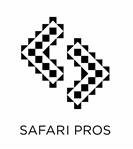Mozambique covers an area of over 800 000 square kilometres (three times the size of Great Britain), and its capital is Maputo. Situated to the south-east of the African continent, it shares borders with six other Commonwealth countries: Tanzania, Malawi and Zambia in the north; Zimbabwe to the west; and South Africa and Swaziland to the south. The 2 500 kilometre-long coastline boasts superb beaches fringed by lagoons, coral reefs and strings of small islands with the Bazaruto and Quirimbas Archipelagos being some of the more well-known ones. The country’s national parks and game reserves, some under private management, are being re-stocked and returned to their former glory while the establishment, with neighbouring countries, of cross-border wildlife reserves is a vital factor in this resurgence. Culturally, Mozambique provides a contrast to other countries in southern and East Africa, with its blend of African, Arab and Portuguese influences.
INTERESTING FACTS
Based on the flag of the Front for the Liberation of Mozambique (FRELIMO), the green stands for the riches of the land, the white fimbriations signify peace, black represents the African continent, yellow symbolises the country's minerals, and red represents the struggle for independence. The rifle stands for defence and vigilance, the open book for the importance of education, the hoe represents the country's agriculture, and the star symbolises Marxism and internationalism.
GOVERNMENT
Mozambique is a multi-party democracy, which gained independence on 25 June 1975. The branches of government consists of The Executive – President, Council of Ministers; The Legislative – National Assembly, municipal assemblies and The Judicial – Supreme Court plus provincial, district and municipal courts. The key political parties are FRELIMO; the Mozambican National Resistance (RENAMO); the Democratic Movement of Mozambique (MDM) and numerous small parties.
ECONOMY
Mozambique’s natural resources include hydroelectric power, coal, natural gas, titanium ore, graphite, iron ore, semi-precious stones, and arable land. Agriculture accounts for about 21% of GDP with exports of cotton, cashew nuts, sugarcane, tea, cassava (tapioca), corn, coconuts, sisal, citrus and tropical fruits, potatoes, sunflowers, beef and poultry. 31% of GDP comes from industry which includes food, beverages, chemicals (fertiliser, soap, paints), aluminium, petroleum products, textiles, cement, glass and tobacco. Tourism is also a contributing factor to the overall GDP.
CURRENCY
The official currency is the Metical (MT), however, US Dollars and South African Rands are more widely used for tourism and many hotels/resorts insist on payment in these foreign currencies. The Metical is made up of 100 Centavos (plural: Meticais, pronounced “Meticash”).
LANGUAGE
The official language of Mozambique is Portuguese, though many people speak English in the capital, Maputo, and in tourist areas. The further north you travel, the less likely you are to encounter English speakers and in the more remote areas you are equally unlikely to encounter Portuguese speakers. On the northern coast, towards Tanzania, Swahili may be helpful.
TIME
Mozambique is two hours ahead of Greenwich Mean Time – (GMT) + 2 hours.
CLIMATE
Two main seasons, one wet and the other dry, divide the climatic year:
- The wet season, from November to March, has a monthly average temperature of between 26°C (79°F) and 29°C (84°F) with cooler temperatures in the interior uplands.
- The dry season lasts from April to October and has June and July temperatures averaging 18°C (64°F) to 20°C (68°F).
- The average annual rainfall is greatest (approximately 1422mm/56 inches) over the western hills and the central areas, and lowest in the Zambezi lowlands averaging 406 to 13mm (16 to 32 inches).
The Bazaruto and Quirimbas Archipelagos seldom gets cold, however, on some evenings during the winter months of June and July, a light jacket or pullover will be necessary.
PUBLIC HOLIDAYS
01 January New Year’s Day
03 February Heroes Day
07 April Women’s Day
01 May Workers Day
25 June Independence Day
07 September Lusaka Agreement Day
25 September Armed Forces Day
04 October Peace Day
19 October Samora Machel Day
25 December Christmas Day
USEFUL INFORMATION
VISAS
Visas are your responsibility. Please check with your nearest Mozambican consulate, embassy or Mozambican diplomatic mission for up to date information as visa requirements can change with little or no notice. Those nationalities that are required to have visas to enter Mozambique may have to apply for these in advance while others can obtain these on arrival at the port of entry. Costs can also vary.
PAYMENT
Metical, US Dollars and South African Rands are widely used for tourism and many hotels/resorts insist on payment in these foreign currencies. Travellers Cheques are widely accepted and readily exchanged, however, to avoid commission they are best taken in US Dollars. If you use Dollars or Rands in the markets or local shops and petrol stations then please watch the exchange rate used. There are no restrictions on the import of foreign currency, however, the import and export of local currency is not allowed.
CREDIT CARDS
Major hotels and some banks accept credit card transactions, however, you will be charged a commission. MasterCard, Visa and American Express credit cards are accepted in many places.
BANKS
Monday to Friday: 07:30 – 15:30
SHOPPING
Mozambique sells unique souvenirs such as basketwork, reed mats, woodcarvings, masks, printed cloth and leather articles.
Value Added Tax
There is a 17% tax levied on all products.
ARRIVAL TAX
On arrival at Vilanculos Airport a minimum fee, paid in US Dollars, is applicable. All other taxes such as Air Passenger Taxes, Safety Tax, Passenger Service Charge and Departure Taxes are included in the price of the air ticket. Please note: Taxes, levies and fees are subject to increase without any prior notification.
POWER
The Mozambique power grid uses 220V/240V running at AC 50Hz. Wall sockets (round 3 pin) are rated to carry a maximum of 15 amps. While some camps can supply adaptors (3-prong round, 3-prong square, 2-prong round, 2-prong flat) it is advisable that you carry your own.


